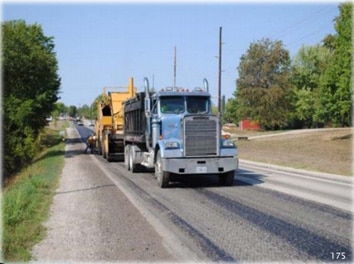Let’s pretend for a moment that our nation has decided to now focus on maintaining (not improving) our current D-rating for infrastructure. The cost to do so, according to the American Association of State Highway and Transportation Officials (AASHTO), is estimated to be $160 billion per year. Want to guess what we are spending now? $80 billion per year. Half! That means the nation’s infrastructure condition is further declining. What if we wanted to actually improve our rating from D to C+ (still not that great of an improvement but a start)? It would take an initial investment of several TRILLION!
There is another (less expensive) way to improve the situation: improving flawed practices.
More than 50% of AC pavements’ design life is routinely forfeited due to lack of focus on interlayer bonding, despite the fact that addressing inadequate bonding is one of the least expensive and easiest problems to fix.
Before we go through the solution, however, it’s important to identify the reasons bonding is overlooked.
TO BE OR NOT TO BE BONDED
Let’s refer to Figure A (from Part I) for the following scenario:

The Pavement Design Engineer likely assumes that a fully-bonded, monolithic structure shown in Figure A is being constructed. This is a common assumption and common mistake. Big red flag! The structure in Figure A is rarely—if ever—constructed. Assuming that completely disregards the impact of the tack coat and interlayer bonding on the design life prediction—a chief role of the pavement design engineer.
As construction day nears, the Material Suppliers and the Mix Design Engineers have met all product specifications and assume no liability for interlayer bonding. The Road Builder submitted a bid that included a cheap (but approved) tack coat material. The cheap tack coat is applied, a period is allowed for set time, and paving operations commence. Then, the majority of the tack coat is removed by haul trucks and paving equipment prior to constructing the surface layer (see Figure C below):

Will the AC surface course (being laid by the paver in background of the photo) be properly bonded to the underlying layer (clearly missing more than 50% of the tack coat in the foreground of the photo)?
The Agency had an inspector on site, but nothing out of the ordinary was taking place that day—just the typical tack coat application and subsequent removal. Looks like there will be a mess to clean up later due to the tracking—this is a tough, dirty job, but someone must do it, right?
AGENCY SPECIFICATIONS
Before we move on, let’s take a look at the Agency specifications (equivalent to laws in the civil engineering world) that were written specifically to protect against adhesive removal. Below are just a few examples:
Agency A: The surface shall be satisfactorily cleaned before tack coat is applied…Asphalt shall be uniformly applied to a clean, dry surface with no bare areas, streaks or puddles… When tack coat has been damaged by traffic pick-up or contaminated by dirt, dust, or mud, the surface shall be cleaned and re-tacked prior to lay-down at no direct pay.
Agency B: The tack coat should be allowed to break and cure until a point in time that the tack coat does not pick-up or track due to traffic from trucks or the paving equipment.
Agency C: The tack coat shall be applied…without pickup or tracking of the bituminous material.
There is virtually no debate among experts regarding the validity of these specifications. They are in place for a reason—because knowledgeable engineers understand the consequence of insufficient bonding and wrote these specifications to ensure adequate bonding. The engineers who wrote the specifications, though, do not typically work in the field. The engineers assume that the specification is met. Why, then, are these specifications NOT being enforced by the Agency?
That is clearly where the problem lies. Specifications are meaningless without enforcement.
PRIMARY FACTORS THAT IMPACT TACK COAT APPLICATION
Before I go any further, I must address the primary factors that impact tack coat application. It can basically be broken into three categories. Remember earlier, I mentioned how EASY it is to fix the issue of poor interlayer bonding. The following is how you fix it.
- Pre-application: Proper product selection, surface preparation, product integrity (avoiding dilution/contamination/segregation), surface inspection
- Application: Correct application temperature, proper application rate (including calibration), uniform spray (100% coverage)
- Post-application/Construction: Set/cure waiting period, avoid adhesive removal/damage* with strict DOT inspection and enforcement, mixture laydown activation (correct mix temperature), superior bond created
*If adhesive removal/damage occurred during step 3, take a closer look at the previous steps and note that QA verification is required at all times.
Ensuring that steps 1-3 occur correctly is VITAL to pavement lifespan.
If you have any questions about the information I’ve presented, please leave them in the comments section below.
In Part III, we’ll explore the overall awareness and official stance of many asphalt experts relative to tack coat best practices and its impact on pavement design life.
